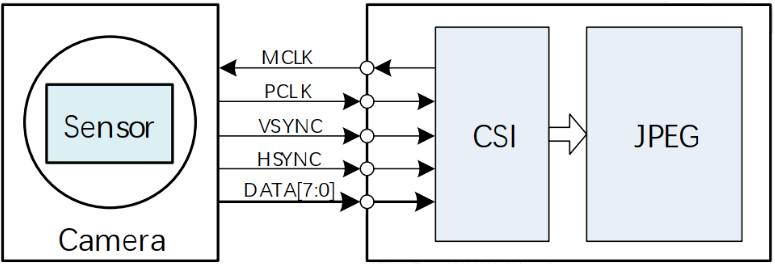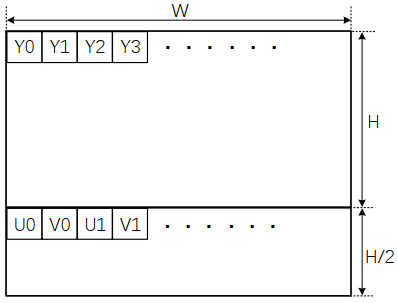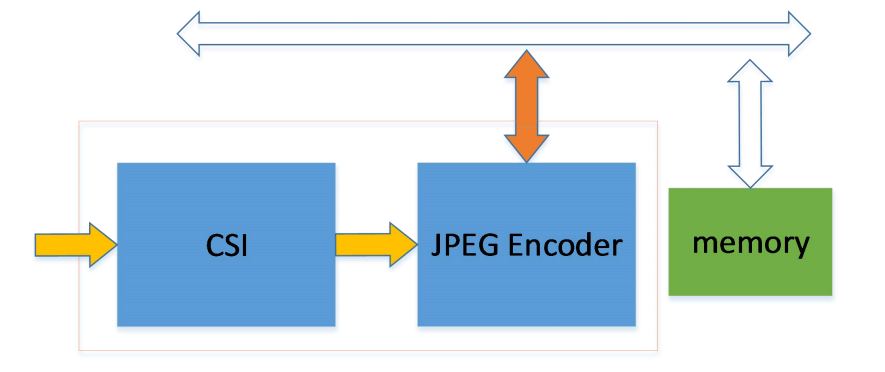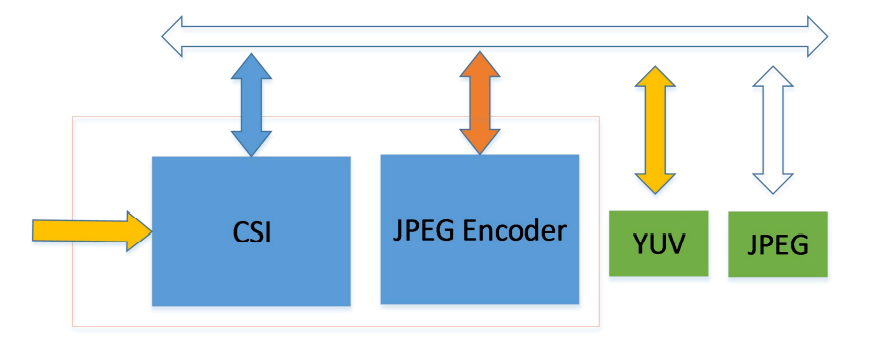|
CSI(DVP) 图像采集SENSOR -> CSI 通路 [color=rgba(0, 0, 0, 0.87)]CSI (CMOS sensor interface)接口时序上可支持独立 SYNC 和嵌入 SYNC(CCIR656)。支持接收 YUV422 或 YUV420 数据。 [color=rgba(0, 0, 0, 0.87)] [color=var(--md-typeset-a-color)] [color=rgba(0, 0, 0, 0.87)]VSYNC 和HSYNC 的有效电平可以是正极性,也可以是负极性。在配置时,需要保证摄像头和 CSI 内部配置保持一致。 [color=rgba(0, 0, 0, 0.87)]最常见的 YUV422 格式输入后,内部只能处理成 YUV420 格式,并输出到 memory 存以 NV12布局形式。 [color=rgba(0, 0, 0, 0.87)] [color=var(--md-typeset-a-color)] [color=rgba(0, 0, 0, 0.87)]JPEG 模块只支持 YUV420 格式的编码,因此 CSI 捕获的数据输出给 JPEG 模块编码的图像格式必须是 YUV420。若 CSI 输入 JPEG 模块是 JPEG 码流,JPEG 模块也能正常将其输出。 编码模式[color=rgba(0, 0, 0, 0.87)]JPEG 模块支持 online 及 offline 模式编码。 - online 模式即在线模式,CSI 每接收到 16 行数据就自动进行 JPEG 编码,当前帧图像接收完,编码也随即完成。该模式 CSI 不会将接收的原始图像数据保存起来,只输出 JPEG 编码后的数据。编码数据输出的方式又有:整帧模式和分块模式。
- offline 模式即离线模式,CSI 接收到的数据会先存到内存中,待一帧完整数据全部存储完成后,由软件启动 JPEG 编码。所以此时 JPEG 不是实时处理,可以对任何已经保存好的 YUV420 图像数据进行编码。
ONLINE 模式[color=rgba(0, 0, 0, 0.87)]Online 模式的通路框图如下图所示: [color=rgba(0, 0, 0, 0.87)] [color=var(--md-typeset-a-color)] [color=rgba(0, 0, 0, 0.87)]Sensor(摄像头) 输出 YUV422 格式数据到 CSI,CSI 接收到 YUV422 后处理成 YUV420 格式,每接收到 16 行数据后,硬件会自动启动 JPEG encoder 进行一次编码操作,编码输出的码流通过总线直接写到设定好的内存中,故可认为 Online 模式下图像的接收和编码是同时进行的。在一帧数据接收完并编码结束后,JPEG encoder 会产生 ve finish(编码完成) 中断。因此,对图像分辨率的要求是行列数为 16 的整数倍,支持的最小分辨率为 32*32。 [color=rgba(0, 0, 0, 0.87)]Online 分块模式与整帧模式的区别在于,分块模式可以在 JPEG 编码输出数据量达到设定值 (例如 2KB/4KB) 后产生中断,并且可以在一帧编码过程中循环使用编码输出空间,例如只分配 8KB的编码输出空间,而一帧图像编码数据有 20KB,则在第一次写满 8KB 后,JPEG 将会从这 8KB的首地址开始存储,循环使用,故需要软件配合将之前的数据读走,否则之前的数据会被覆盖。 OFFLINE 模式[color=rgba(0, 0, 0, 0.87)]Offline 模式的通路框图如下图所示: [color=rgba(0, 0, 0, 0.87)] [color=var(--md-typeset-a-color)] [color=rgba(0, 0, 0, 0.87)]Offline 模式下,CSI 会将 YUV420 的原始图像数据存储到 YUV memory 中,存放格式为NV12。一帧图像全部存完后,产生写回中断 (wb finish),然后由软件启动 JPEG 开始编码, JPEG 编码器会读取 YUV memory 中的原始数据送给 Encoder 进行编码,编码后的数据写到JPEG memory 中。 模块配置menuconfig 配置说明[color=rgba(0, 0, 0, 0.87)]其 menuconfig 的配置如下(以选择GC0308 摄像头为例): code" style="box-sizing: inherit; -webkit-tap-highlight-color: transparent; font-size: inherit; font-family: inherit; background-image: initial; background-position: initial; background-size: initial; background-repeat: initial; background-attachment: initial; background-origin: initial; background-clip: initial; border-width: 0px; border-style: initial; border-color: initial; position: absolute; top: 0.5em; right: 0.5em; z-index: 1; width: 1.5em; height: 1.5em; border-radius: 0.1rem; outline: none; outline-offset: 0.1rem; cursor: pointer; transition: color 0.25s ease 0s;">Drivers Options ---> soc related device drivers ---> CSI Devices ---> [* enable csi driver [* enable csi camera driver [* csi camera choice ---> --- csi camera choice [* csi camera GC0308 [* enable jpeg encoder [* enable csi demo test command // csi_jpeg模块测试用例Copy to clipboardErrorCopied板级配置说明[color=rgba(0, 0, 0, 0.87)]请根据硬件原理图,进行CSI 模块引脚配置。具体配置举例如下: code" style="box-sizing: inherit; -webkit-tap-highlight-color: transparent; font-size: inherit; font-family: inherit; background-image: initial; background-position: initial; background-size: initial; background-repeat: initial; background-attachment: initial; background-origin: initial; background-clip: initial; border-width: 0px; border-style: initial; border-color: initial; position: absolute; top: 0.5em; right: 0.5em; z-index: 1; width: 1.5em; height: 1.5em; border-radius: 0.1rem; outline: none; outline-offset: 0.1rem; cursor: pointer; transition: color 0.25s ease 0s;">;‑‑‑‑‑‑‑‑‑‑‑‑‑‑‑‑‑‑‑‑‑‑‑‑‑‑‑‑‑‑‑‑‑‑‑‑‑‑‑‑‑‑‑‑‑‑‑‑‑‑‑‑‑‑‑‑‑‑‑‑‑‑‑‑‑‑‑‑‑‑‑‑‑‑‑‑‑‑‑‑;vip (video input port) configuration;vip_used: 0:disable 1:enable;‑‑‑‑‑‑‑‑‑‑‑‑‑‑‑‑‑‑‑‑‑‑‑‑‑‑‑‑‑‑‑‑‑‑‑‑‑‑‑‑‑‑‑‑‑‑‑‑‑‑‑‑‑‑‑‑‑‑‑‑‑‑‑‑‑‑‑‑‑‑‑‑‑‑‑‑‑‑‑‑[csi0]vip_used = 1vip_csi_hsync = port:PA18<7><0><3><default>vip_csi_vsync = port:PA19<7><0><3><default>vip_csi_pck = port:PA20<7><0><3><default>vip_csi_mck = port:PA21<7><0><3><default>vip_csi_d0 = port:PA22<8><0><3><default>vip_csi_d1 = port:PA23<8><0><3><default>vip_csi_d2 = port:PA27<8><0><3><default>vip_csi_d3 = port:PA26<8><0><3><default>vip_csi_d4 = port:PA29<8><0><3><default>vip_csi_d5 = port:PA25<8><0><3><default>vip_csi_d6 = port:PA24<8><0><3><default>vip_csi_d7 = port:PA28<8><0><3><default>vip_dev0_twi_id = 1vip_dev0_reset = port:PA10<1><0><3><0>vip_dev0_pwdn = port:PA11<1><0><3><0>源码结构[color=rgba(0, 0, 0, 0.87)]驱动位于 rtos-hal/hal/source/drivers/hal/source/csi code" style="box-sizing: inherit; -webkit-tap-highlight-color: transparent; font-size: inherit; font-family: inherit; background-image: initial; background-position: initial; background-size: initial; background-repeat: initial; background-attachment: initial; background-origin: initial; background-clip: initial; border-width: 0px; border-style: initial; border-color: initial; position: absolute; top: 0.5em; right: 0.5em; z-index: 1; width: 1.5em; height: 1.5em; border-radius: 0.1rem; outline: none; outline-offset: 0.1rem; cursor: pointer; transition: color 0.25s ease 0s;">csi/├── csi_camera/ ;csi driver│ ├── csi.c│ ├── csi.h│ ├── csi_reg/│ │ ├── csi_reg.c│ │ └── csi_reg.h│ └── sensor/ ;cmos sensor driver│ ├── drv_gc0308.c│ ├── sensor_helper.c│ └── sensor_helper.h├── hal_csi_jpeg.c ;csi_jpeg模块驱动实现主体├── jpeg/ ;jpeg driver│ ├── hal_jpeg.c│ ├── hal_jpeg.h│ ├── jpegenc.c│ ├── jpegenc.h│ ├── jpeglib.c│ ├── jpeglib.h│ ├── jpeg_marker.h│ └── jpeg_reg/│ ├── jpeg_reg.c│ └── jpeg_reg.h└── utility ├── cj_board_cfg.h ├── cj_platform_cfg.h └── sensor/ ├── camera_sensor.h └── drv_gc0308.h接口使用说明[color=rgba(0, 0, 0, 0.87)]详细说明见 [color=var(--md-typeset-a-color)]SDK HAL 模块开发指南 - CSI 模块接口说明 常见问题- 画面看起来像油画效果,过渡渐变的地方有一圈一圈
- 一般是CSI 的data 线没有接好,或短路,或断路。
- 画面大体轮廓正常,颜色出现大片绿色和紫红色
- 一般可能是CSI 采样到的yuyv 顺序出现错位。确认camera 输出的yuyv 顺序的设置与camera 的spec 是否一致。
- 若camera 输出的yuyv 顺序没有问题,则可能是由于走线问题,导致pclk 采样data 时发生错位,此时可以调整pclk 的采样沿。具体做法如下:
- 在对应的camara 驱动源码,如drv_gc0308.c 里面,找到宏定义#define CLK_POL。此宏定义可以有两个值MBUS_PCLK_SAMPLE_RISING 和MBUS_PCLK_SAMPLE_FALLING。若原来是其中一个值,则修改成另外一个值,便可将PCLK 的采样沿做反相。
- 画面大体轮廓正常,但出现不规则的绿色紫色条纹
- 一般可能是pclk 驱动能力不足,导致某个时刻采样data 时发生错位。
- 若 pclk 走线上有串联电阻,尝试将电阻阻值减小。
- 增强 pclk 的驱动能力,需要设置camera 的内部寄存器。
UVC (USB Video Class) 图像采集[color=rgba(0, 0, 0, 0.87)]FreeRTOS UVC 参考linux v4l2 框架,对接usb 驱动,实现对usb camera 的配置、使用。usb camera在FreeRTOS 应用端,与linux camera 应用类似,通过ioctl 操作进行分辨率配置、图像获取等操作。 模块配置 code" style="box-sizing: inherit; -webkit-tap-highlight-color: transparent; font-size: inherit; font-family: inherit; background-image: initial; background-position: initial; background-size: initial; background-repeat: initial; background-attachment: initial; background-origin: initial; background-clip: initial; border-width: 0px; border-style: initial; border-color: initial; position: absolute; top: 0.5em; right: 0.5em; z-index: 1; width: 1.5em; height: 1.5em; border-radius: 0.1rem; outline: none; outline-offset: 0.1rem; cursor: pointer; transition: color 0.25s ease 0s;">‑> Drivers Options ‑> soc related device drivers ‑> USB Drivers ‑> USB HOST Support usb host ehci0 Support usb host ohci0 UVC support模块接口说明[color=rgba(0, 0, 0, 0.87)]当前支持的 ioctl 主要有: [color=rgba(0, 0, 0, 0.87)]ioctl 参数结构 描述
VIDIOC_QUERYCAPstruct v4l2_capability获取uvc driver 信息,实际使用可忽略该ioctl
VIDIOC_S_PARMstruct v4l2_streamparm设置帧率
VIDIOC_S_FMTstruct v4l2_format设置分辨率
VIDIOC_REQBUFSstruct v4l2_requestbuffers申请接收buf
VIDIOC_QBUFstruct v4l2_buffer将buf 添加到驱动待使用
VIDIOC_DQBUFstruct v4l2_buffer从驱动获取填充了图像数据的buf
VIDIOC_STREAMONenum v4l2_buf_type type开始传输usb camera 数据
VIDIOC_STREAMOFFenum v4l2_buf_type type停止传输usb camera 数据
VIDIOC_QUERYCAP[color=rgba(0, 0, 0, 0.87)]获取uvc driver 信息,可不调用。 code" style="box-sizing: inherit; -webkit-tap-highlight-color: transparent; font-size: inherit; font-family: inherit; background-image: initial; background-position: initial; background-size: initial; background-repeat: initial; background-attachment: initial; background-origin: initial; background-clip: initial; border-width: 0px; border-style: initial; border-color: initial; position: absolute; top: 0.5em; right: 0.5em; z-index: 1; width: 1.5em; height: 1.5em; border-radius: 0.1rem; outline: none; outline-offset: 0.1rem; cursor: pointer; transition: color 0.25s ease 0s;">struct v4l2_capability cap; /* Query device capabilities *//* Query device capabilities */memset(&cap, 0, sizeof(cap));if (ioctl(fd, VIDIOC_QUERYCAP, &cap) < 0) { printf(" Query device capabilities fail!!!\n");} else { printf(" Querey device capabilities succeed\n"); printf(" cap.driver=%s\n", cap.driver); printf(" cap.card=%s\n", cap.card); printf(" cap.bus_info=%s\n", cap.bus_info); printf(" cap.version=0x%08x\n", cap.version); printf(" cap.capabilities=0x%08x\n", cap.capabilities);}VIDIOC_S_PARM[color=rgba(0, 0, 0, 0.87)]usb camera 本身支持多帧率的,可以通过VIDIOC_S_PARM 配置输出的帧率。 code" style="box-sizing: inherit; -webkit-tap-highlight-color: transparent; font-size: inherit; font-family: inherit; background-image: initial; background-position: initial; background-size: initial; background-repeat: initial; background-attachment: initial; background-origin: initial; background-clip: initial; border-width: 0px; border-style: initial; border-color: initial; position: absolute; top: 0.5em; right: 0.5em; z-index: 1; width: 1.5em; height: 1.5em; border-radius: 0.1rem; outline: none; outline-offset: 0.1rem; cursor: pointer; transition: color 0.25s ease 0s;">struct v4l2_streamparm parms; /* set streaming parameters *//* set streaming parameters */memset(&parms, 0, sizeof(struct v4l2_streamparm));parms.type = V4L2_BUF_TYPE_VIDEO_CAPTURE;parms.parm.capture.timeperframe.numerator = 1;parms.parm.capture.timeperframe.denominator = 30; /* 通过denominator 配置帧率*/if (ioctl(fd, VIDIOC_S_PARM, &parms) < 0) { printf(" Setting streaming parameters failed, numerator:%d denominator:%d\n", parms.parm.capture.timeperframe.numerator, parms.parm.capture.timeperframe.denominator); close(fd); return ‑1;}VIDIOC_S_FMT[color=rgba(0, 0, 0, 0.87)]配置分辨率和图像输出格式。 code" style="box-sizing: inherit; -webkit-tap-highlight-color: transparent; font-size: inherit; font-family: inherit; background-image: initial; background-position: initial; background-size: initial; background-repeat: initial; background-attachment: initial; background-origin: initial; background-clip: initial; border-width: 0px; border-style: initial; border-color: initial; position: absolute; top: 0.5em; right: 0.5em; z-index: 1; width: 1.5em; height: 1.5em; border-radius: 0.1rem; outline: none; outline-offset: 0.1rem; cursor: pointer; transition: color 0.25s ease 0s;">struct v4l2_format fmt; /* setting format *//* set the data format */memset(&fmt, 0, sizeof(struct v4l2_format));fmt.type = V4L2_BUF_TYPE_VIDEO_CAPTURE;fmt.fmt.pix.width = 1920; /* 分辨率的宽*/fmt.fmt.pix.height = 1080; /* 分辨率的高*/fmt.fmt.pix.pixelformat = V4L2_PIX_FMT_MJPEG; /* 输出格式*/fmt.fmt.pix.field = V4L2_FIELD_INTERLACED;if (ioctl(fd, VIDIOC_S_FMT, &fmt) < 0) { printf(" setting the data format failed!\n"); close(fd); return ‑1;}VIDIOC_REQBUFS[color=rgba(0, 0, 0, 0.87)]底层需要有buf 接收usb camera 传输过来的数据,通过VIDIOC_REQBUFS 可以指定申请多少个buf 给驱动使用。 code" style="box-sizing: inherit; -webkit-tap-highlight-color: transparent; font-size: inherit; font-family: inherit; background-image: initial; background-position: initial; background-size: initial; background-repeat: initial; background-attachment: initial; background-origin: initial; background-clip: initial; border-width: 0px; border-style: initial; border-color: initial; position: absolute; top: 0.5em; right: 0.5em; z-index: 1; width: 1.5em; height: 1.5em; border-radius: 0.1rem; outline: none; outline-offset: 0.1rem; cursor: pointer; transition: color 0.25s ease 0s;">struct v4l2_requestbuffers req; /* Initiate Memory Mapping or User Pointer I/O *//* Initiate Memory Mapping or User Pointer I/O */memset(&req, 0, sizeof(struct v4l2_requestbuffers));req.count = 3; /* 申请的buf个数,该数值需要大于或等于3,当count 为0时则是释放buf */req.type = V4L2_BUF_TYPE_VIDEO_CAPTURE;req.memory = V4L2_MEMORY_MMAP;if (ioctl(fd, VIDIOC_REQBUFS, &req) < 0) { printf(" VIDIOC_REQBUFS failed\n"); close(fd); return ‑1;}VIDIOC_QBUF[color=rgba(0, 0, 0, 0.87)]uvc 驱动需要知道当前有多少个空闲buf 可以使用,需要通过VIDIOC_QBUF 将空闲buf 添加给驱动使用。 code" style="box-sizing: inherit; -webkit-tap-highlight-color: transparent; font-size: inherit; font-family: inherit; background-image: initial; background-position: initial; background-size: initial; background-repeat: initial; background-attachment: initial; background-origin: initial; background-clip: initial; border-width: 0px; border-style: initial; border-color: initial; position: absolute; top: 0.5em; right: 0.5em; z-index: 1; width: 1.5em; height: 1.5em; border-radius: 0.1rem; outline: none; outline-offset: 0.1rem; cursor: pointer; transition: color 0.25s ease 0s;">struct v4l2_buffer buf; /* Query the status of a buffer */memset(&buf, 0, sizeof(struct v4l2_buffer));buf.index = n_buffers;/* uvc驱动通过buf.index 获取得到相应的buf 信息,所以index *//* 不能超过VIDIOC_REQBUFS 申请的 buf数量,同时,VIDIOC_REQBUFS 申请得到buf *//* 之后应通过QBUF 添加到uvc 驱动。当VIDIOC_DQBUF 得到buf 使用 *//* 完之后也应该进行VIDIOC_QBUF。*/if (ioctl(fd, VIDIOC_QBUF, &buf) == ‑1) { printf(" VIDIOC_QBUF error\n"); close(fd); return ‑1;}VIDIOC_DQBUF[color=rgba(0, 0, 0, 0.87)]获取uvc 驱动已经填充好图像数据的buf,该操作在uvc 驱动没有填充完成的buf 时会阻塞。 code" style="box-sizing: inherit; -webkit-tap-highlight-color: transparent; font-size: inherit; font-family: inherit; background-image: initial; background-position: initial; background-size: initial; background-repeat: initial; background-attachment: initial; background-origin: initial; background-clip: initial; border-width: 0px; border-style: initial; border-color: initial; position: absolute; top: 0.5em; right: 0.5em; z-index: 1; width: 1.5em; height: 1.5em; border-radius: 0.1rem; outline: none; outline-offset: 0.1rem; cursor: pointer; transition: color 0.25s ease 0s;">struct v4l2_buffer buf; /* Query the status of a buffer */memset(&buf, 0, sizeof(struct v4l2_buffer));if (ioctl(fd, VIDIOC_DQBUF, &buf) == ‑1) { printf(" VIDIOC_DQBUF error\n"); close(fd); return ‑1;}[color=rgba(0, 0, 0, 0.87)]在VIDIOC_DQBUF 操作成功返回之后, buf.mem_buf 指向的是保存图像数据的内存位置,而buf.length 则是图像数据的有效长度。 VIDIOC_STREAMON[color=rgba(0, 0, 0, 0.87)]在完成配置之后,通过VIDIOC_STREAMON 使能usb camera 输出图像数据。 code" style="box-sizing: inherit; -webkit-tap-highlight-color: transparent; font-size: inherit; font-family: inherit; background-image: initial; background-position: initial; background-size: initial; background-repeat: initial; background-attachment: initial; background-origin: initial; background-clip: initial; border-width: 0px; border-style: initial; border-color: initial; position: absolute; top: 0.5em; right: 0.5em; z-index: 1; width: 1.5em; height: 1.5em; border-radius: 0.1rem; outline: none; outline-offset: 0.1rem; cursor: pointer; transition: color 0.25s ease 0s;">enum v4l2_buf_type type;/* streamon */type = V4L2_BUF_TYPE_VIDEO_CAPTURE;if (ioctl(fd, VIDIOC_STREAMON, &type) == ‑1) { printf(" VIDIOC_STREAMON error! %s\n", strerror(errno));} else { printf(" stream on succeed\n");}VIDIOC_STREAMOFF[color=rgba(0, 0, 0, 0.87)]在完成配置之后,通过VIDIOC_STREAMON 使能usb camera 输出图像数据。 code" style="box-sizing: inherit; -webkit-tap-highlight-color: transparent; font-size: inherit; font-family: inherit; background-image: initial; background-position: initial; background-size: initial; background-repeat: initial; background-attachment: initial; background-origin: initial; background-clip: initial; border-width: 0px; border-style: initial; border-color: initial; position: absolute; top: 0.5em; right: 0.5em; z-index: 1; width: 1.5em; height: 1.5em; border-radius: 0.1rem; outline: none; outline-offset: 0.1rem; cursor: pointer; transition: color 0.25s ease 0s;">enum v4l2_buf_type type;/* streamon */type = V4L2_BUF_TYPE_VIDEO_CAPTURE;if (ioctl(fd, VIDIOC_STREAMOFF, &type) == ‑1) { printf(" VIDIOC_STREAMOFF error! %s\n", strerror(errno));} else printf(" stream off succeed\n");接口使用流程[color=rgba(0, 0, 0, 0.87)]FreeRTOS uvc 应用流程需要先设置帧率、分辨率、格式等参数,然后申请buf,将buf 提供给驱动,然后开启传输。关闭传输之后,需要释放buf 再释放相应的句柄。 code" style="box-sizing: inherit; -webkit-tap-highlight-color: transparent; font-size: inherit; font-family: inherit; background-image: initial; background-position: initial; background-size: initial; background-repeat: initial; background-attachment: initial; background-origin: initial; background-clip: initial; border-width: 0px; border-style: initial; border-color: initial; position: absolute; top: 0.5em; right: 0.5em; z-index: 1; width: 1.5em; height: 1.5em; border-radius: 0.1rem; outline: none; outline-offset: 0.1rem; cursor: pointer; transition: color 0.25s ease 0s;">fd = open(/dev/video, xxx)ioctl(fd, VIDIOC_QUERYCAP, xxx)ioctl(fd, VIDIOC_S_PARM, xxx) //设置帧率ioctl(fd, VIDIOC_S_FMT, xxx) //设置分辨率和格式ioctl(fd, VIDIOC_REQBUFS, xxx) //申请buf,count >= 3for(; < count; ) ioctl(fd, VIDIOC_QBUF, xxx) //将buf都提供给uvc驱动ioctl(fd, VIDIOC_STREAMON, xxx) //开启流传输whileioctl(fd, VIDIOC_DQBUF, xxx) //获取填充好的buf数据app use buf...ioctl(fd, VIDIOC_QBUF, xxx) //buf使用完之后还给uvc驱动ioctl(fd, VIDIOC_STREAMOFF, xxx) //停止流传输ioctl(fd, VIDIOC_REQBUFS, xxx) //释放buf,count = 0close(fd) //释放句柄[color=rgba(0, 0, 0, 0.87)]FreeRTOS 目前仅支持单摄接收。 模块使用范例[color=rgba(0, 0, 0, 0.87)]前提条件:机器接上电源,并且机器的USB接口通过OTG线连接上USB摄像头 code" style="box-sizing: inherit; -webkit-tap-highlight-color: transparent; font-size: inherit; font-family: inherit; background-image: initial; background-position: initial; background-size: initial; background-repeat: initial; background-attachment: initial; background-origin: initial; background-clip: initial; border-width: 0px; border-style: initial; border-color: initial; position: absolute; top: 0.5em; right: 0.5em; z-index: 1; width: 1.5em; height: 1.5em; border-radius: 0.1rem; outline: none; outline-offset: 0.1rem; cursor: pointer; transition: color 0.25s ease 0s;">#include <fcntl.h>#include <sys/ioctl.h>#include "usb_test.h"#include "uvcvideo.h"extern int msleep(unsigned int msecs);static void *uvc_thread = NULL;static void *file_thread = NULL;static hal_mailbox_t uvc_mailbox = NULL;static int save_frame_to_file(void *str, void *start, int length) { FILE *fp = NULL; fp = fopen(str, "wb+"); // save more frames if (!fp) { printf(" Open %s error\n", (char *)str); return -1; } if (fwrite(start, length, 1, fp)) { fclose(fp); return 0; } else { printf(" Write file fail (%s)\n", strerror(errno)); fclose(fp); return -1; } return 0;}void usb_uvc_file_thread(void *para) { char source_data_path[64; unsigned int value = 0; struct v4l2_buffer *mailbuf; int np = 0; while (1) { hal_mailbox_recv(uvc_mailbox, &value, -1); if (value != 0) { mailbuf = (struct v4l2_buffer *)(uintptr_t)value; printf("np = %d\n", np); sprintf(source_data_path, "/data/source_frame_%d.jpg", np++); save_frame_to_file(source_data_path, (uint32_t *)((int64_t)mailbuf->mem_buf), mailbuf->length); free((void *)((int64_t)mailbuf->mem_buf)); free(mailbuf); mailbuf = NULL; value = 0; } }}void usb_uvc_test_thread(void *para) { int fd; struct v4l2_capability cap; /* Query device capabilities */ struct v4l2_streamparm parms; /* set streaming parameters */ struct v4l2_format fmt; /* try a format */ struct v4l2_requestbuffers req; /* Initiate Memory Mapping or User Pointer I/O */ struct v4l2_buffer buf; /* Query the status of a buffer */ struct v4l2_buffer *mailbuf = NULL; enum v4l2_buf_type type; int n_buffers; int np; /* 1.open /dev/videoX node */ fd = open("/dev/video", O_RDWR); /* 2.Query device capabilities */ memset(&cap, 0, sizeof(cap)); if (ioctl(fd, VIDIOC_QUERYCAP, &cap) < 0) { printf(" Query device capabilities fail!!!\n"); } else { printf(" Querey device capabilities succeed\n"); printf(" cap.driver=%s\n", cap.driver); printf(" cap.card=%s\n", cap.card); printf(" cap.bus_info=%s\n", cap.bus_info); printf(" cap.version=0x%08x\n", cap.version); printf(" cap.capabilities=0x%08x\n", cap.capabilities); } /* 7.set streaming parameters */ memset(&parms, 0, sizeof(struct v4l2_streamparm)); parms.type = V4L2_BUF_TYPE_VIDEO_CAPTURE; parms.parm.capture.timeperframe.numerator = 1; parms.parm.capture.timeperframe.denominator = 30; if (ioctl(fd, VIDIOC_S_PARM, &parms) < 0) { printf( " Setting streaming parameters failed, numerator:%d denominator:%d\n", parms.parm.capture.timeperframe.numerator, parms.parm.capture.timeperframe.denominator); close(fd); return; } /* 9.set the data format */ memset(&fmt, 0, sizeof(struct v4l2_format)); fmt.type = V4L2_BUF_TYPE_VIDEO_CAPTURE; fmt.fmt.pix.field = V4L2_FIELD_INTERLACED; fmt.fmt.pix.width = 320; fmt.fmt.pix.height = 240; fmt.fmt.pix.pixelformat = V4L2_PIX_FMT_MJPEG; if (ioctl(fd, VIDIOC_S_FMT, &fmt) < 0) { printf(" setting the data format failed!\n"); close(fd); return; } /* 10.Initiate Memory Mapping or User Pointer I/O */ memset(&req, 0, sizeof(struct v4l2_requestbuffers)); req.count = 5; req.type = V4L2_BUF_TYPE_VIDEO_CAPTURE; req.memory = V4L2_MEMORY_MMAP; if (ioctl(fd, VIDIOC_REQBUFS, &req) < 0) { printf(" VIDIOC_REQBUFS failed\n"); close(fd); return; } /* 11.Exchange a buffer with the driver */ for (n_buffers = 0; n_buffers < req.count; n_buffers++) { memset(&buf, 0, sizeof(struct v4l2_buffer)); buf.index = n_buffers; if (ioctl(fd, VIDIOC_QBUF, &buf) == -1) { printf(" VIDIOC_QBUF error\n"); close(fd); return; } } /* streamon */ type = V4L2_BUF_TYPE_VIDEO_CAPTURE; if (ioctl(fd, VIDIOC_STREAMON, &type) == -1) { printf(" VIDIOC_STREAMON error! %s\n", strerror(errno)); } else printf(" stream on succeed\n"); np = 0; while (1) { printf(" camera capture num is [%d]\n", np); /* wait uvc frame */ memset(&buf, 0, sizeof(struct v4l2_buffer)); if (ioctl(fd, VIDIOC_DQBUF, &buf) == -1) { printf(" VIDIOC_DQBUF error\n"); goto EXIT; } else { // printf("*****DQBUF[%d] FINISH*****\n", buf.index); } mailbuf = malloc(sizeof(struct v4l2_buffer)); mailbuf->mem_buf = (uint32_t)(uintptr_t)malloc(buf.length); if (mailbuf->mem_buf != 0) { memcpy((uint32_t *)((uint64_t)mailbuf->mem_buf), (uint32_t *)((uint64_t)buf.mem_buf), buf.length); mailbuf->length = buf.length; if (hal_mailbox_send_wait(uvc_mailbox, (uint32_t)(uintptr_t)mailbuf, 100) < 0) { printf("uvc data send failed, data lost\n"); } } if (ioctl(fd, VIDIOC_QBUF, &buf) == -1) { printf(" VIDIOC_QBUF error\n"); goto EXIT; } else { printf("************QBUF[%d] FINISH**************\n\n", buf.index); } np++; } printf("\n\n Capture thread finish\n");EXIT: type = V4L2_BUF_TYPE_VIDEO_CAPTURE; ioctl(fd, VIDIOC_STREAMOFF, &type); memset(&req, 0, sizeof(struct v4l2_requestbuffers)); req.count = 0; req.type = V4L2_BUF_TYPE_VIDEO_CAPTURE; req.memory = V4L2_MEMORY_MMAP; ioctl(fd, VIDIOC_REQBUFS, &req); close(fd); while (hal_is_queue_empty(uvc_mailbox) != 1) { msleep(100); } printf("close.......\n"); hal_mailbox_delete(uvc_mailbox); hal_thread_stop(file_thread); hal_thread_stop(uvc_thread);}int usb_test_cmd_uvc(int argc, const char **argv) { uvc_mailbox = hal_mailbox_create("ucv_queue", 320); if (uvc_mailbox == NULL) { printf("mailbox create failed\n"); goto fail_exit1; } printf("uvc_mailbox create sucess!\n"); // usb thread is HAL_THREAD_PRIORITY_SYS,must be lower than // HAL_THREAD_PRIORITY_SYS uvc_thread = hal_thread_create(usb_uvc_test_thread, NULL, "uvc_thread", 4 * 1024, (HAL_THREAD_PRIORITY_APP + 1)); if (uvc_thread == NULL) { printf("usb_uvc_test_thread create failed\n"); goto fail_exit2; } hal_thread_start(uvc_thread); file_thread = hal_thread_create(usb_uvc_file_thread, NULL, "uvc_file_thread", 2 * 1024, (HAL_THREAD_PRIORITY_APP)); if (file_thread == NULL) { printf("uvc file thread create failed\n"); goto fail_exit3; } hal_thread_start(file_thread); return 0;fail_exit3: hal_thread_stop(uvc_thread);fail_exit2: hal_mailbox_delete(uvc_mailbox);fail_exit1: return -1;}[color=rgba(0, 0, 0, 0.87)]测试命令:usb uvc_test [color=rgba(0, 0, 0, 0.87)]测试结果:在小机端/data/目录下生成图像文件(source_frame_X.jpg)
|